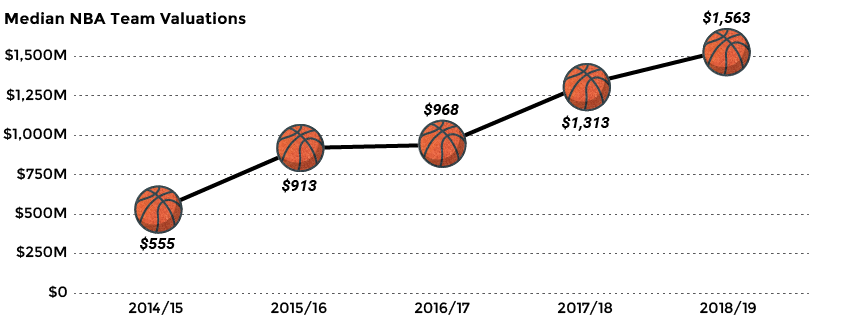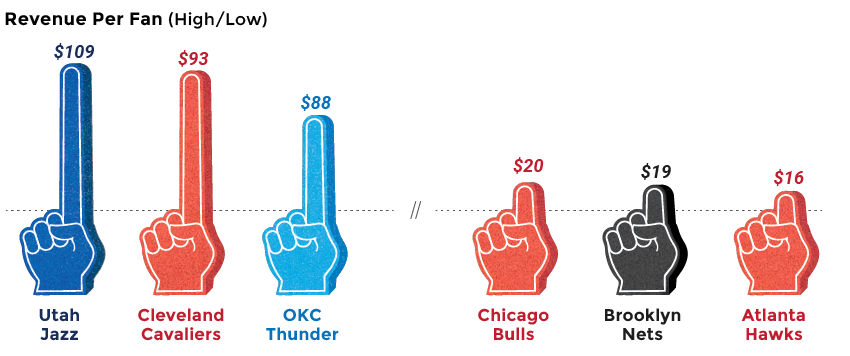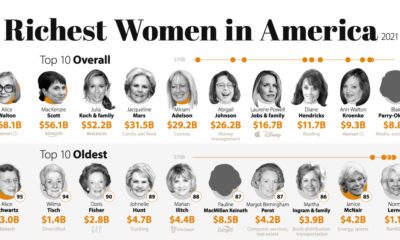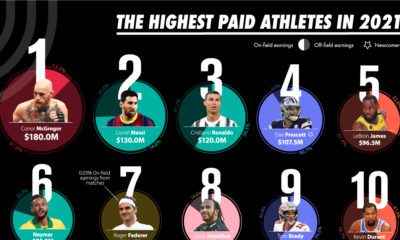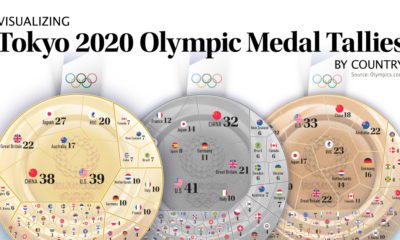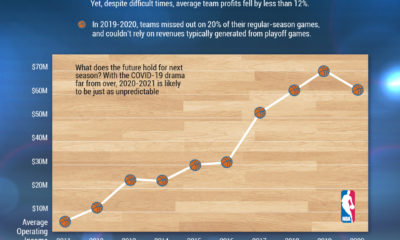At the beginning of this decade, the NBA was not on firm footing. More than half of the league’s teams were losing money, and negotiations on a new collective bargaining agreement were looming. Today, however, the NBA has undeniable momentum, buoyed by hefty broadcast agreements and superstars like LeBron James and Steph Curry. With interest in the NFL flagging in the U.S., professional basketball appears to be seizing the opportunity to win over sports fans and grow the popularity of the league. This momentum has pushed team valuations to new heights, with the median team now being worth a solid $1.56 billion. What are the exact valuations of individual franchises in the league, and how are these values derived? Let’s dig into Forbes’ annual NBA Valuations Ranking to learn more.
Breaking down team value
Forbes has broken down the value of an NBA team valuations into four components: Sport: The revenue shared equally among all teams in the league Market: City and market size Arena: Revenues from sources such as attendance and premium seating Brand: The actual value of the team’s brand
Every single team in the NBA is now valued at over $1 billion, and all but one team (the Cavaliers) were profitable last year. For teams like the Knicks and Lakers, it’s easy to see how their huge market size contributes to their sky-high valuations. The former is currently the second-most-valuable sports franchise in America, tied with the New York Yankees. While the biggest teams are worth more than double the NBA median value, the rising tide appears to be lifting all boats. The median team value has risen steadily and is up nearly 200% since 2014.
Gold Rush
The biggest story in basketball over recent years has been the ascension of the Golden State Warriors. Making the NBA finals four seasons in a row – and winning three of those match-ups – has had a massive impact on the team’s value, which has shot up 367% over the last five years. As the team moves to the brand new Chase Center next season, Golden State may even have a shot at surpassing the Knicks or Lakers in overall valuation. Here are the top five gainers over the past five years:
Fan Power
The teams with the highest revenue-per-fan are typically in smaller markets like Salt Lake City and Oklahoma City, though both cities are unique in that an NBA franchise is their only professional sports team. The struggling Chicago Bulls comes in near the bottom by revenue-per-fan, despite being the fourth most valuable team in the league.
Shifting Gravity
In recent years, LeBron James has been one of the most electrifying personalities in professional sports, however, his influence on the NBA is now proving to be a double-edged sword. Since LeBron moved time zones from Cleveland to Los Angeles, NBA viewership is down – a dip that is particularly pronounced during the earlier Eastern Conference time slot. Despite the slight dip in viewership, NBA teams are more profitable than they’ve ever been, and as the NBA turns its sights eastward to China, today’s valuations may seem modest in a few years time. on Even while political regimes across these countries have changed over time, they’ve largely followed a few different types of governance. Today, every country can ultimately be classified into just nine broad forms of government systems. This map by Truman Du uses information from Wikipedia to map the government systems that rule the world today.
Countries By Type of Government
It’s important to note that this map charts government systems according to each country’s legal framework. Many countries have constitutions stating their de jure or legally recognized system of government, but their de facto or realized form of governance may be quite different. Here is a list of the stated government system of UN member states and observers as of January 2023: Let’s take a closer look at some of these systems.
Monarchies
Brought back into the spotlight after the death of Queen Elizabeth II of England in September 2022, this form of government has a single ruler. They carry titles from king and queen to sultan or emperor, and their government systems can be further divided into three modern types: constitutional, semi-constitutional, and absolute. A constitutional monarchy sees the monarch act as head of state within the parameters of a constitution, giving them little to no real power. For example, King Charles III is the head of 15 Commonwealth nations including Canada and Australia. However, each has their own head of government. On the other hand, a semi-constitutional monarchy lets the monarch or ruling royal family retain substantial political powers, as is the case in Jordan and Morocco. However, their monarchs still rule the country according to a democratic constitution and in concert with other institutions. Finally, an absolute monarchy is most like the monarchies of old, where the ruler has full power over governance, with modern examples including Saudi Arabia and Vatican City.
Republics
Unlike monarchies, the people hold the power in a republic government system, directly electing representatives to form government. Again, there are multiple types of modern republic governments: presidential, semi-presidential, and parliamentary. The presidential republic could be considered a direct progression from monarchies. This system has a strong and independent chief executive with extensive powers when it comes to domestic affairs and foreign policy. An example of this is the United States, where the President is both the head of state and the head of government. In a semi-presidential republic, the president is the head of state and has some executive powers that are independent of the legislature. However, the prime minister (or chancellor or equivalent title) is the head of government, responsible to the legislature along with the cabinet. Russia is a classic example of this type of government. The last type of republic system is parliamentary. In this system, the president is a figurehead, while the head of government holds real power and is validated by and accountable to the parliament. This type of system can be seen in Germany, Italy, and India and is akin to constitutional monarchies. It’s also important to point out that some parliamentary republic systems operate slightly differently. For example in South Africa, the president is both the head of state and government, but is elected directly by the legislature. This leaves them (and their ministries) potentially subject to parliamentary confidence.
One-Party State
Many of the systems above involve multiple political parties vying to rule and govern their respective countries. In a one-party state, also called a single-party state or single-party system, only one political party has the right to form government. All other political parties are either outlawed or only allowed limited participation in elections. In this system, a country’s head of state and head of government can be executive or ceremonial but political power is constitutionally linked to a single political movement. China is the most well-known example of this government system, with the General Secretary of the Communist Party of China ruling as the de facto leader since 1989.
Provisional
The final form of government is a provisional government formed as an interim or transitional government. In this system, an emergency governmental body is created to manage political transitions after the collapse of a government, or when a new state is formed. Often these evolve into fully constitutionalized systems, but sometimes they hold power for longer than expected. Some examples of countries that are considered provisional include Libya, Burkina Faso, and Chad.

